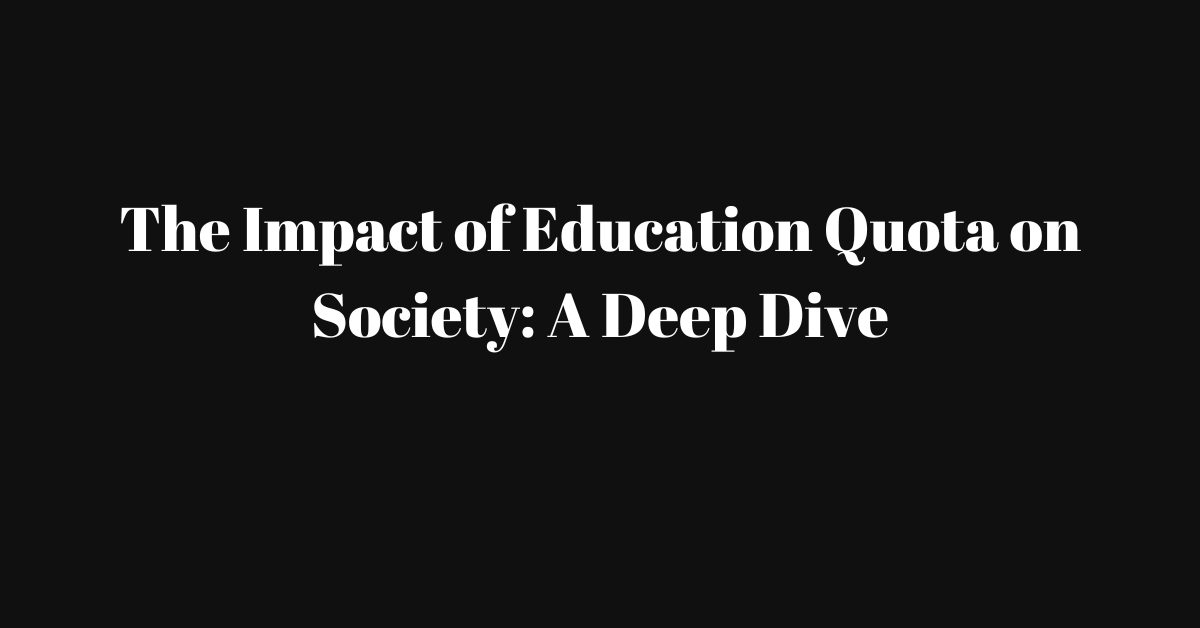Introduction
Education is a powerful tool for individual and societal growth. However, access to quality education is not always equal. To address disparities, many countries implement education quotas, reserving seats for disadvantaged groups in educational institutions. While these quotas aim to promote inclusivity, they also generate debates about meritocracy, fairness, and long-term impact.
This article explores the impact of education quotas on society, analyzing both the positive outcomes and the challenges they present.
Understanding Education Quotas
Education quotas are policies that allocate a percentage of seats in schools, colleges, and universities to specific groups. These groups are often marginalized due to economic, social, or historical disadvantages. Common types of quotas include:
- Caste-based Quotas (e.g., for Scheduled Castes, Scheduled Tribes, and Other Backward Classes in India)
- Economic Quotas (for students from economically weaker backgrounds)
- Gender-Based Quotas (to support female education)
- Disability Quotas (ensuring equal access for students with disabilities)
- Regional Quotas (helping students from underdeveloped areas)
Positive Impact of Education Quotas
Education quotas have several benefits that contribute to a more equitable society:
1. Promoting Social Inclusion
Education quotas help integrate marginalized communities into mainstream education, reducing societal inequality and fostering a sense of belonging.
2. Reducing Economic Disparities
By providing access to quality education for underprivileged students, quotas help break the cycle of poverty and open doors to better career opportunities.
3. Enhancing Diversity in Educational Institutions
A diverse student body encourages cross-cultural understanding and promotes tolerance, preparing students for global workplaces.
4. Encouraging Higher Education Enrollment
Many students from disadvantaged backgrounds may not consider higher education due to financial constraints or social barriers. Quotas provide them with a fair chance.
5. Empowering Women and Minorities
Gender-based and minority quotas encourage participation from groups that have historically faced discrimination, helping create a more balanced workforce.
Challenges and Criticisms of Education Quotas
Despite their benefits, education quotas face significant challenges:
1. Meritocracy vs. Reservation Debate
Critics argue that quotas may prioritize reserved candidates over more meritorious ones, leading to concerns about declining academic standards.
2. Misuse and Corruption
Fake caste or income certificates are sometimes used to unfairly claim quota benefits, undermining the policy’s intent.
3. Limited Seats, High Competition
While quotas reserve seats, the number of applicants often exceeds availability, leading to increased competition even among disadvantaged students.
4. Social Stigma
Students admitted through quotas sometimes face discrimination from peers and faculty, affecting their confidence and academic performance.
5. Need for Additional Support
Many quota students come from educationally weaker backgrounds and require extra academic assistance to bridge learning gaps.
Global Perspectives on Education Quotas
Countries worldwide adopt different approaches to educational inclusivity:
- India: Implements caste and economic quotas in government and private institutions.
- United States: Uses affirmative action to promote racial and socio-economic diversity.
- Brazil: Reserves seats for Afro-Brazilians and indigenous students in public universities.
- South Africa: Ensures education access for historically disadvantaged communities.
The Future of Education Quotas
To improve the effectiveness of education quotas, policymakers must consider several reforms:
- Income-Based Reservations: Prioritizing economic status over caste or ethnicity to ensure true financial need is addressed.
- Merit-Linked Quotas: Combining reservation with academic performance to maintain education standards.
- Stronger Verification Processes: Preventing fraud by implementing stringent documentation checks.
- Additional Academic Support: Offering mentorship programs and scholarships to help quota students succeed.
- Awareness Campaigns: Educating eligible students and parents about quota benefits and application procedures.
Conclusion
Education quotas are a vital tool for social and economic development, offering opportunities to those who have been historically marginalized. While challenges exist, refining and improving these policies can create a more inclusive and progressive society. The key lies in balancing equity with merit, ensuring that all students, regardless of background, receive quality education and an equal chance to succeed.
By fostering inclusivity and bridging educational gaps, the education quota system contributes to long-term societal growth, paving the way for a more just and prosperous future.
